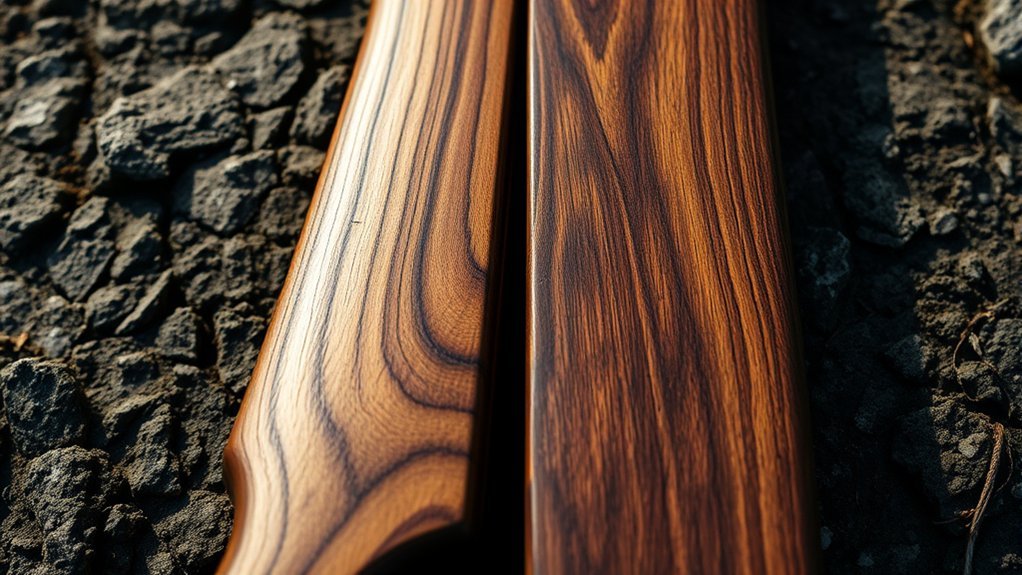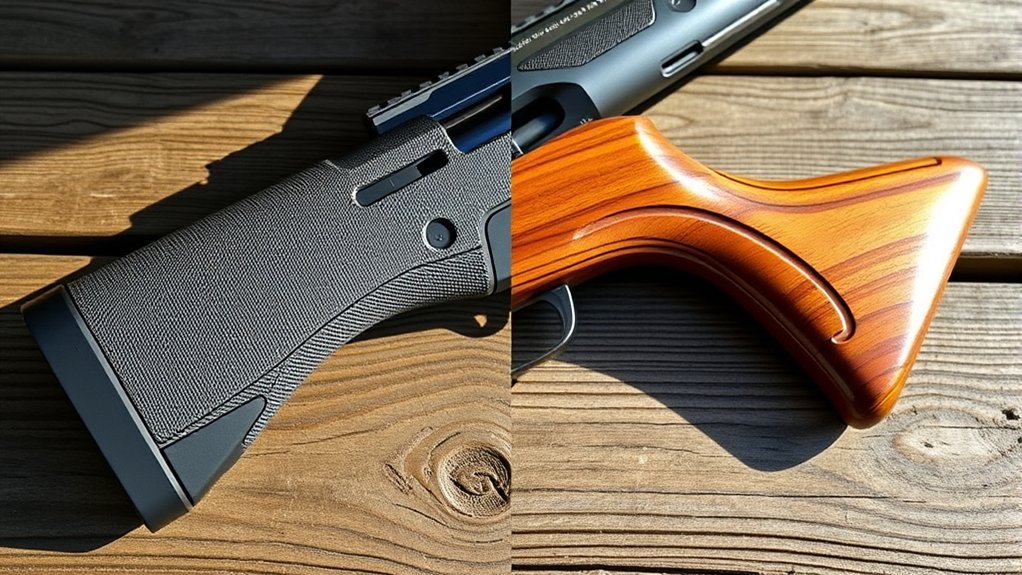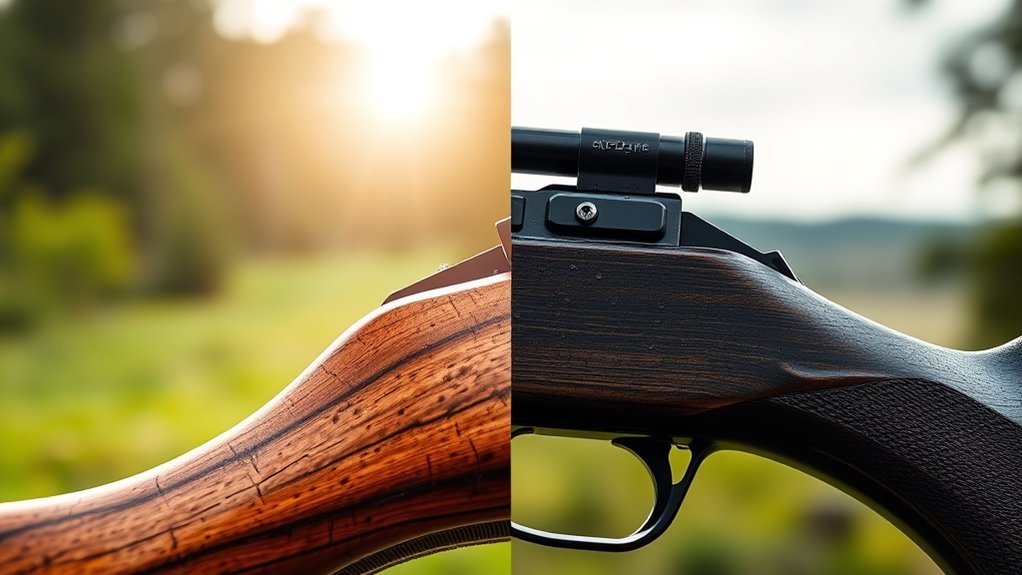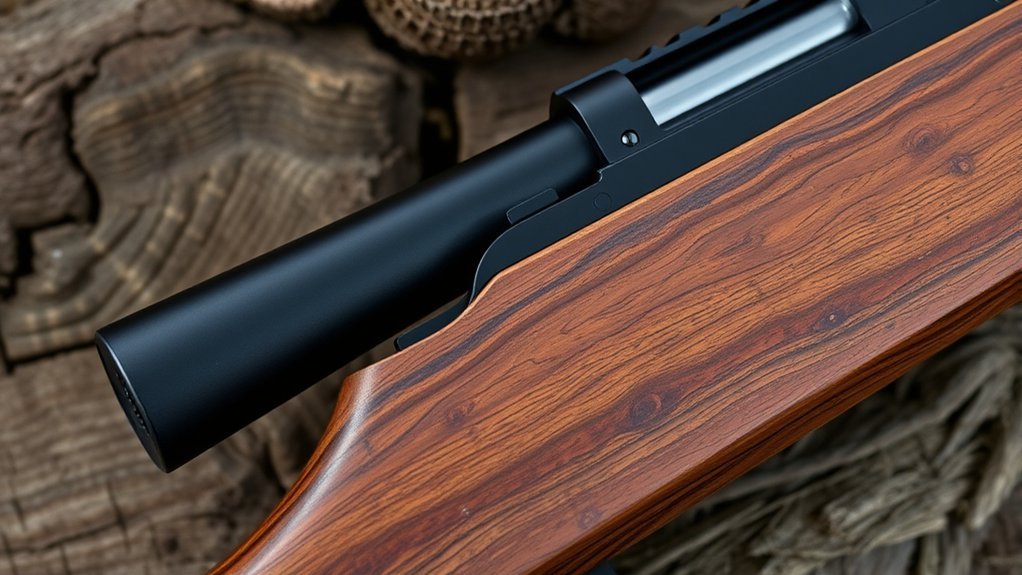When it comes to durability, the choice between polymer and wooden stocks can greatly impact your experience. Polymer stocks offer superior moisture resistance and stability, while wooden stocks often struggle with warping and decay. You’ll want to reflect on how these factors affect performance in various environments. As we explore the differences, you may find that one material clearly stands out regarding longevity and maintenance.
Understanding Polymer Stocks

When you consider the materials used in firearm stocks, polymer stocks stand out due to their durability and resistance to environmental factors. These stocks are typically made from high-strength thermoplastics, which offer significant advantages over traditional materials. Their lightweight nature enhances maneuverability, while their ability to withstand extreme temperatures, moisture, and UV exposure guarantees longevity in varied conditions. Additionally, polymer stocks are less prone to warping or cracking compared to wood, maintaining structural integrity over time. The manufacturing process allows for intricate designs and ergonomic features, enhancing user comfort and performance. Overall, the use of polymer in firearm stocks presents a practical choice for shooters seeking reliability and resilience in demanding environments.
Understanding Wooden Stocks

Wooden stocks have long been favored in the firearms community for their aesthetic appeal and traditional craftsmanship. They offer a unique blend of beauty and functionality, often crafted from hardwoods like walnut or maple. This choice of material provides excellent shock absorption, contributing to overall shooting comfort. Additionally, the density of wood can enhance stability and balance, improving accuracy during use.
However, wooden stocks are subject to environmental factors, such as humidity and temperature changes, which can lead to warping or cracking over time. Maintenance, including regular oiling and cleaning, is essential to preserve their integrity. Ultimately, while wooden stocks deliver a timeless look and feel, their durability can be compromised without proper care, making them less forgiving than their polymer counterparts.
Weather Resistance of Polymer

Although wooden stocks can be susceptible to environmental damage, polymer stocks excel in weather resistance, making them a practical choice for various conditions. Their synthetic materials provide numerous advantages, including:
- Waterproof: Polymer stocks resist moisture, preventing warping and swelling.
- UV Stability: They withstand sunlight exposure without fading or degradation.
- Temperature Resilience: Polymer maintains structural integrity across extreme temperatures.
- Chemical Resistance: These stocks endure exposure to solvents and oils without damage.
- Low Maintenance: Unlike wood, polymer requires minimal upkeep to retain its appearance.
Weather Resistance of Wood
While wood can offer aesthetic appeal and a traditional feel, its weather resistance falls short compared to polymer alternatives. Wood is susceptible to moisture, which can lead to warping, rotting, and mold growth. In contrast, polymers are engineered to withstand harsh conditions.
Here’s a comparison of weather-related factors for wood:
| Factor | Wood | Polymer |
|---|---|---|
| Moisture Resistance | Low | High |
| UV Resistance | Moderate | High |
| Temperature Tolerance | Variable | Consistent |
| Longevity in Weather | Shorter lifespan | Extended lifespan |
| Maintenance Required | High | Low |
Impact Resistance: Polymer Vs Wood
Impact resistance is a critical factor when evaluating stocks for firearms, as it directly influences durability and functionality during use. When comparing polymer and wood stocks, you’ll notice key differences:
Impact resistance is essential in firearm stocks, affecting both durability and functionality, especially when comparing polymer and wood options.
- Polymer stocks typically absorb shock better, reducing the risk of fracture.
- Wood stocks can splinter or crack upon severe impact, potentially compromising performance.
- Weight affects handling; polymers often weigh less, improving maneuverability.
- Temperature fluctuations can affect wood’s integrity, while polymers remain stable under various conditions.
- Aesthetics may matter; wood offers a classic look, but its resilience is sometimes lower than that of polymers.
Understanding these differences helps you make an informed decision based on your shooting needs and the environments you’ll encounter.
Maintenance and Care for Polymer Stocks
To maintain polymer stocks effectively, you’ll want to employ specific cleaning techniques that prevent damage and preserve the material’s integrity. Proper storage recommendations are also essential in ensuring longevity and performance. Understanding these aspects will help you keep your polymer stocks in ideal condition.
Cleaning Techniques
Maintaining a polymer stock requires specific cleaning techniques to guarantee longevity and peak performance. To effectively care for your stock, follow these guidelines:
- Use a soft cloth or sponge with mild soap and warm water.
- Avoid harsh chemicals or solvents that can degrade the polymer material.
- Rinse thoroughly to eliminate any soap residue.
- Dry completely with a clean, lint-free cloth to prevent moisture buildup.
- Regularly inspect for scratches or wear, addressing issues promptly.
Storage Recommendations
While proper cleaning is crucial, effective storage of polymer stocks plays an essential role in their long-term performance. To maintain their integrity, store your polymer stocks in a cool, dry environment, away from direct sunlight and extreme temperatures. High heat can warp the material, while excessive moisture may lead to mold or mildew. Use protective cases or padded storage solutions to prevent physical damage during transport. Avoid stacking heavy objects on or near your stocks to prevent deformation. Regularly inspect your storage conditions and maintain ventilation to minimize humidity. By following these guidelines, you’ll enhance the durability of your polymer stocks, guaranteeing they remain functional and reliable for years to come.
Maintenance and Care for Wooden Stocks
Maintaining wooden stocks requires specific cleaning techniques to preserve their integrity and appearance. You’ll need to regularly clean the wood surface with appropriate products that prevent damage while removing dirt and debris. Additionally, protecting the wood against moisture is essential to prevent warping and deterioration over time.
Cleaning Techniques for Wood
To guarantee your wooden stocks remain in ideal condition, it is crucial to adopt proper cleaning techniques. Regular maintenance guarantees longevity and preserves aesthetics. Here are some recommended techniques:
- Use a soft, dry cloth to remove dust and debris.
- Apply a gentle wood cleaner specifically designed for firearms.
- Avoid harsh chemicals that can damage the finish.
- Wipe down the stock with a microfiber cloth to prevent scratches.
- Apply a thin coat of quality wood oil to nourish the wood and enhance its appearance.
Protecting Against Moisture
Moisture poses a considerable threat to wooden stocks, as it can lead to warping, swelling, and even rot. To protect your wooden stock, first make sure it’s sealed with a high-quality finish, such as oil or polyurethane, which provides a barrier against moisture. Regularly inspect the finish for wear and reapply as needed to maintain its integrity. Store your firearm in a controlled environment with low humidity levels, ideally between 30-50%. You might also consider using silica gel packets or dehumidifiers in your storage area. When cleaning, always dry the wood thoroughly to prevent moisture retention. By following these practices, you’ll greatly enhance the longevity and durability of your wooden stock against moisture-related damage.
Longevity and Lifespan of Both Materials
While both polymer and wooden stocks have their merits, their longevity and lifespan can vary considerably based on factors such as usage, maintenance, and environmental conditions. Here’s a breakdown of how each material typically performs:
- Polymer Stocks: Resistant to moisture, impact, and temperature changes, often lasting decades with minimal maintenance.
- Wooden Stocks: Can last a long time but are susceptible to warping, cracking, and decay if not properly cared for.
- Maintenance: Regular upkeep prolongs lifespan—polymer requires less, while wood needs oiling and sealing.
- Environmental Factors: Exposure to extreme conditions (humidity, sunlight) affects both, but wood is generally more vulnerable.
- Usage: Frequent use can wear both materials down, but polymer’s resilience tends to outperform wood under stress.
Understanding these differences helps in making an informed choice.
Aesthetic Considerations
When considering aesthetic aspects, visual appeal plays an essential role in your choice between polymer and wooden stocks. Wooden stocks often offer a classic, traditional look that can be enhanced with various finishes, while polymer stocks provide a modern, tactical appearance with customization options. Your preference for style and personalization can greatly influence your decision.
Visual Appeal
Many enthusiasts consider the visual appeal of a firearm to be as important as its functionality. When comparing polymer and wooden stocks, various aesthetic factors come into play that can influence your choice.
- Finish: Wooden stocks often feature rich stains and natural grain patterns, while polymer stocks typically come in solid colors.
- Texture: Wood provides a tactile warmth, whereas polymers can offer a modern, sleek feel.
- Design: Wooden stocks can show intricate craftsmanship, while polymers prioritize streamlined, utilitarian designs.
- Weight: Wood tends to be heavier, which some find visually appealing; polymer stocks are lighter, emphasizing practicality.
- Durability: While primarily functional, the durability of the finish affects long-term appearance, influencing your decision.
Ultimately, your preference will depend on the balance between aesthetics and performance.
Customization Options
Customization options for stocks can greatly enhance both the functionality and aesthetic appeal of your firearm. When considering polymer stocks, you’ll find a variety of colors, textures, and finishes available, allowing you to create a unique look. Many polymer stocks also feature modular designs, enabling you to add accessories like grips or cheek risers that improve ergonomics and personalization. In contrast, wooden stocks offer the possibility of intricate woodworking, stains, and varnishes, allowing for a classic, elegant appearance. You can also select different wood types, each contributing to the firearm’s overall character. Ultimately, your choice between polymer and wood may hinge on whether you prioritize modern versatility or traditional craftsmanship in your customization efforts.
Cost and Value Analysis
Cost plays an essential role in the decision-making process when choosing between polymer and wooden stocks. You’ll want to reflect on several factors to evaluate the value each option provides:
- Initial Purchase Price: Polymer stocks usually cost less upfront than wooden stocks.
- Longevity: While wooden stocks can be durable, polymer often withstands harsher conditions.
- Maintenance Costs: Wooden stocks may require more upkeep, potentially increasing long-term expenses.
- Resale Value: Wooden stocks can retain higher resale value if well-maintained.
- Customization Costs: Modifications to polymer stocks tend to be cheaper and easier.
Conclusion
In the battle of durability, polymer stocks clearly edge out wooden stocks, but what does this mean for you? If you rely on your equipment in extreme conditions, the choice becomes critical. Imagine facing the elements with a wooden stock, only to find it warped or cracked when you need it most. On the other hand, polymer’s resilience offers peace of mind. Ultimately, your decision could impact performance, longevity, and, importantly, your next adventure. Choose wisely.

